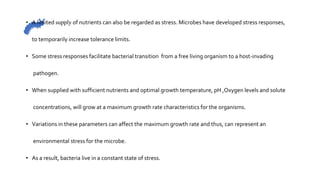Microbial stress response
- 2. Just like human beings, microbes have to deal with continuous stress. However, stress for microbes is different from the stress humans are used to-it causes damage to macromolecules, membranes, proteins and nucleic acids. It can be chemical stress, caused by toxic and harmful compounds, or physical stress. For example heat.
- 3. • A limited supply of nutrients can also be regarded as stress. Microbes have developed stress responses, to temporarily increase tolerance limits. • Some stress responses facilitate bacterial transition from a free living organism to a host-invading pathogen. • When supplied with sufficient nutrients and optimal growth temperature, pH ,Oxygen levels and solute concentrations, will grow at a maximum growth rate characteristics for the organisms. • Variations in these parameters can affect the maximum growth rate and thus, can represent an environmental stress for the microbe. • As a result, bacteria live in a constant state of stress.
- 4. • Cells respond to hypoosmotic environment by sudden rapid cell swelling, but within minutes, they start to return to their original volume
- 5. • Osmotic stress----- • Bacteria experience osmotic stress when the osmotic pressure of their environment is variable, extremely low, or extremely high. • Osmotic stress tolerance mechanisms determine whether bacteria survive or grow because osmotic stress profoundly affects the structure, physics, and chemistry of bacterial cells. • Water flows out of cell as their medium become more concentrated and into cells as their medium becomes more dilute. • Bacteria attenuates such water fluxes by accumulating and releasing electrolytes and small organic solutes.
- 6. Basically Osmotic stress is a sudden change in the solute concentration around a cell, causing change in the movement of water across its cell Membrane. OSMOTIC STRESS HYPEROSMOTIC HYPOOSMOTIC
- 7. THANKYOU






